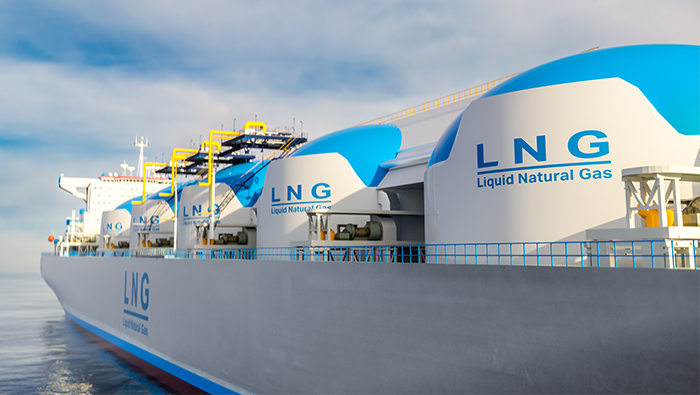
Muscat: The GCC region has been one of the key regions eyed by the EU countries for LNG supplies in their bid to diversify away from Russian energy, according to a new report.
State oil companies in the region such as UAE’s flagship company Adnoc are taking advantage of the Russia-Ukraine conflict to expand their natural gas production and simultaneously increase their investment commitments to target Europe’s gas market, the Kuwait-based Kamco Investment said in its latest Natural Gas Market Update May 2023, report.
“Adnoc (Abu Dhabi National Oil Company) is currently constructing additional LNG capacity and increasing its international natural gas production footprint in other states in the Middle East region. The company has announced it has taken a strategic stake in Israel’s offshore gas company NewMed Energy.”
“Moreover, the energy company has also reported that its subsidiary, Adnoc Logistics & Services deployed five new Very Large Gas Carriers (VLGCs) which were built in China. The ships are intended to ship LPG further developing Adnoc s ability to meet the growing worldwide gas demand.
On the other hand, Qatar regained its position as the world’s largest LNG exporter in 2022 according to Gas Exporting Countries Forum (GECF). The Kamco Invest report further said that Qatar has exported an estimated 80 million tonnes of LNG during 2022 followed by Australia (79 million tonnes), the USA (78 million tonnes) and Russia (32 million tonnes).
In 2022, the US was the primary driver in global LNG exports with other gas-exporting countries such as Qatar, Russia and Norway contributing little to the rise in LNG exports. In contrast to 2022, things look different so far. In March-2023, Qatar was the driving force of LNG exports in GECF member states. Total growth in LNG exports by GECF states rose 6.7 per cent (1.11 million tonnes) y-o-y during March-2023 to reach 17.66 million tonnes. Qatar represented 0.62 million tonnes or 56 per cent of the total LNG export increases by the GECF member countries. The rise in Qatar’s LNG exports was attributed to lower maintenance activity in 2023 as compared to 2022.
World natural gas prices
The Kamco Invest report further said that natural gas prices have been plummeting since the start of the year. Moderate winter demand and negative sentiment towards industrial consumption fuelled by the US Federal Reserve’s aggressive rate increases adversely impacted the demand outlook. The monthly World Bank Natural Gas Index dropped 59.1 per cent in the last six months, underscoring the commodity’s weaker global sentiment.
Last winter, European countries for the first time faced winter gas shortages as a result of the Russia-Ukraine conflict crisis. However, the winter gas shortages have not materialised for European countries because of mild winters and EU states securing alternatives to Russian gas. This eased negative gas market sentiment towards European countries’ ability to obtain alternative gas supplies thereby pushing down global natural gas prices.
According to the World Bank, US natural gas prices for April-2023 decreased by 66.9 per cent year-on-year (y-o-y) to reach $2.16 per Metric Million British Thermal Unit (MMBtu). Similarly, European natural gas prices for April-2023 declined by 58.0 per cent y-o-y averaging the month at $13.52 per MMBtu, while the average monthly Japanese LNG price for April-2023 witnessed a 3.4 per cent y-o-y drop at $15.73 per MMBtu. Natural gas and LNG spot prices in Europe and Asia witnessed three consecutive monthly declines between December-2022 to March-2023. In March-2023, NEA LNG spot prices averaged $13.35 per MMBtu while the TTF average monthly spot prices hovered around $13.87 per MMBtu.
In terms of consumption, global natural gas consumption is forecasted to grow around one per cent in 2023 driven by the US, China, and certain emerging markets especially in the Asia Pacific region, according to the Gas Exporting Countries Forum. EU gas consumption has been falling throughout the last three months of the year. EU gas consumption fell 19 per cent y-o-y to 40 billion cubic metres (bcm) in January-2023 mainly driven by above-average temperatures which impacted demand for heating in the residential sector as well as gas consumption reduction measures.
Comparatively, US gas consumption declined by 8.8 per cent y-o-y mainly due to the deceleration of industrial activity as well as warmer temperatures. For February-2023, EU gas consumption recorded a marginal drop of 0.1 per cent y-o-y to reach 38.5 bcm while natural gas consumption in the US witnessed a 5.9 per cent y-o-y decrease during the same period. The European Union’s natural gas consumption continued to decrease during March-2023 as the bloc recorded a 13 per cent y-o-y decline to 34.1bcm.
As natural gas demand in Europe and the US waned, China’s natural gas consumption has increased since the start of 2023. In February-2023 natural gas demand in China increased by 4.6 per cent y-o-y to 31bcm, mainly due to the relaxation of the pandemic measures and the bite of colder than expected weather.
China’s natural gas demand is expected to grow by 19bcm or 5.1 per cent in 2023 to reach 386.5bcm, according to the CNPC Research Institute. Growth in China’s industrial sector especially by steel and glass is forecasted to drive the lion’s share of the country’s consumption growth during the year. Japan’s gas consumption dropped by 1.9 per cent y-o-y during March-2023 to 9bcm, mostly driven by the bite of energy-saving policies and the impact of mild winter weather. In contrast, India’s natural gas consumption recorded 4.2 per cent y-o-y growth in both January-2023 and February-2023 to reach 4.5 bcm in February-2023.
Growth in India’s natural gas consumption was mainly propped up by the revival of the country’s fertiliser sector which witnessed a 31 percent y-o-y increase in February-2023.